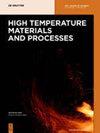新型热作模具钢5CrNiMoVNb的热稳定性研究
IF 1.5
4区 材料科学
Q4 MATERIALS SCIENCE, MULTIDISCIPLINARY
引用次数: 1
摘要
摘要通过优化5CrNiMoV钢的合金成分,研制出一种新型热作模具钢5CrNiMoVNb。进行了热稳定性试验,比较了两种钢的硬度演变。5CrNiMoVNb在600°C和650°C时的硬度降低仅为4.3HRC和9.6HRC,而5CrNiMoV钢在相同条件下的硬度降低分别高达6.5HRC和17.5HRC,这表明5CrNiMoVNb钢的热稳定性更为优异。通过微观结构分析和热力学计算,研究了5CrNiMoVNb的热稳定机理。这说明高温回火导致部分碳化物粗化,抑制了马氏体基体的恢复和再结晶,是导致热稳定性略有下降的主要原因。加入中、强碳化物形成元素后,5CrNiMoVNb钢中碳化物以粗化率系数较低的MC和M23C6为主,且在670℃以下含量基本不变。细小的MC和M23C6碳化物对位错和抑制马氏体恢复和再结晶表现出强烈的钉住和拖拽作用。因此,新型热作模具钢比5CrNiMoV钢具有更好的回火软化性能和热稳定性。本文章由计算机程序翻译,如有差异,请以英文原文为准。
Investigation into the thermal stability of a novel hot-work die steel 5CrNiMoVNb
Abstract A novel hot-work die steel 5CrNiMoVNb is developed by optimizing the alloy composition of 5CrNiMoV steel. Thermal stability tests were carried out to compare the hardness evolution of the two steel types. The hardness reduction of 5CrNiMoVNb at 600 and 650°C was only 4.3HRC and 9.6HRC, while that of 5CrNiMoV steel at the same condition was as large as 6.5HRC and 17.5HRC, respectively, which suggests that the thermal stability of the 5CrNiMoVNb steel is more excellent. The thermal stability mechanism of 5CrNiMoVNb was studied based on microstructure analyses and thermodynamic calculations. This suggests that high tempering temperatures cause the coarsening of some carbides and suppress the recovery and recrystallization of the martensite matrix, which is the main reason for the slight decrease in the thermal stability. For the adding of the medium and strong carbide-forming elements, the carbides in 5CrNiMoVNb steel are mainly MC and M23C6 with low coarsening rate coefficient, and the content of these two carbides is almost constant below 670°C. The fine MC and M23C6 carbides showed strong pinning and dragging effects on the dislocations and suppressed martensite recovery and recrystallization. Therefore, the novel hot-work die steel showed excellent tempering softening resistance and thermal stability than 5CrNiMoV steel.
求助全文
通过发布文献求助,成功后即可免费获取论文全文。
去求助
来源期刊

High Temperature Materials and Processes
工程技术-材料科学:综合
CiteScore
2.50
自引率
0.00%
发文量
42
审稿时长
3.9 months
期刊介绍:
High Temperature Materials and Processes offers an international publication forum for new ideas, insights and results related to high-temperature materials and processes in science and technology. The journal publishes original research papers and short communications addressing topics at the forefront of high-temperature materials research including processing of various materials at high temperatures. Occasionally, reviews of a specific topic are included. The journal also publishes special issues featuring ongoing research programs as well as symposia of high-temperature materials and processes, and other related research activities.
Emphasis is placed on the multi-disciplinary nature of high-temperature materials and processes for various materials in a variety of states. Such a nature of the journal will help readers who wish to become acquainted with related subjects by obtaining information of various aspects of high-temperature materials research. The increasing spread of information on these subjects will also help to shed light on relevant topics of high-temperature materials and processes outside of readers’ own core specialties.
 求助内容:
求助内容: 应助结果提醒方式:
应助结果提醒方式:


